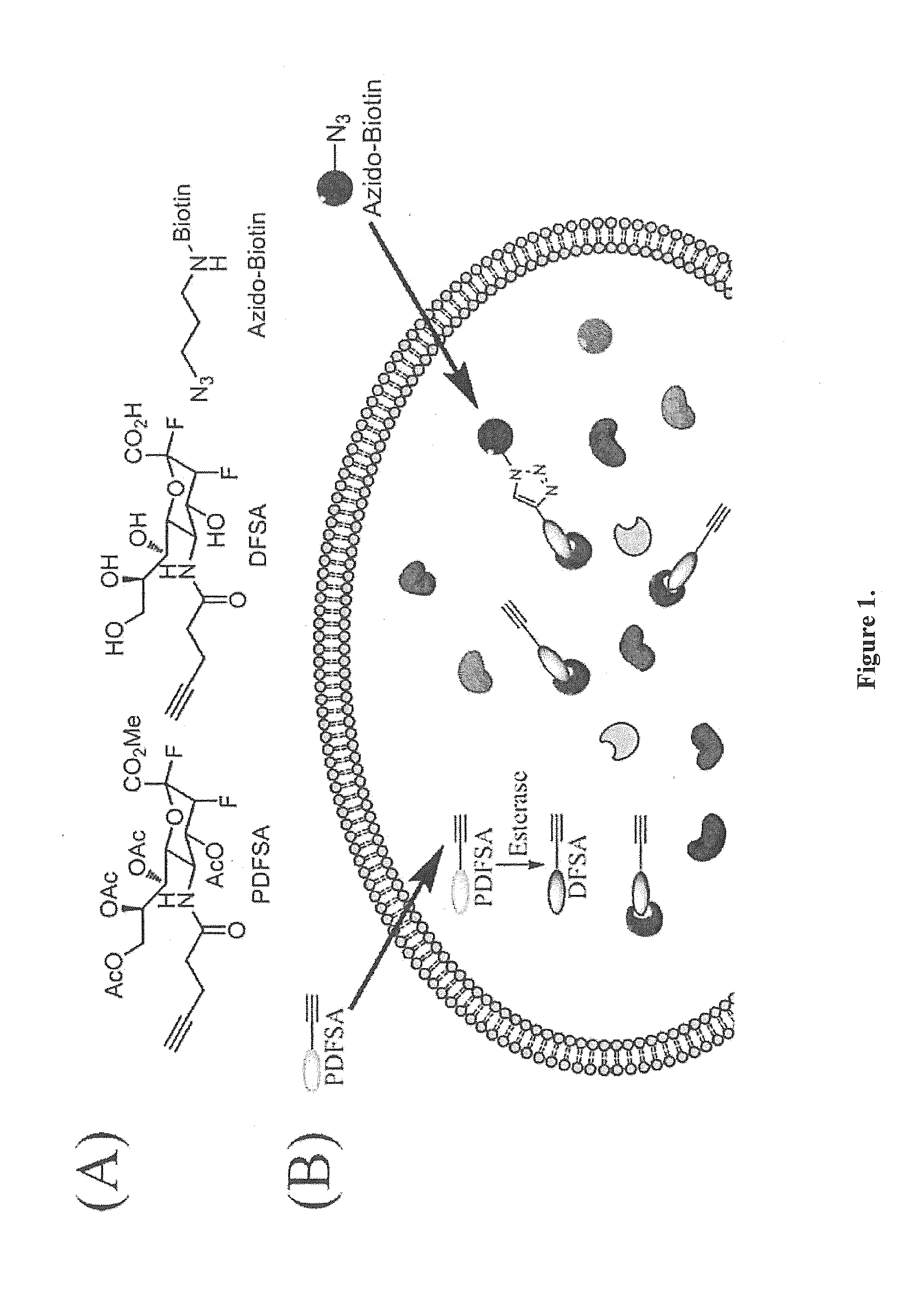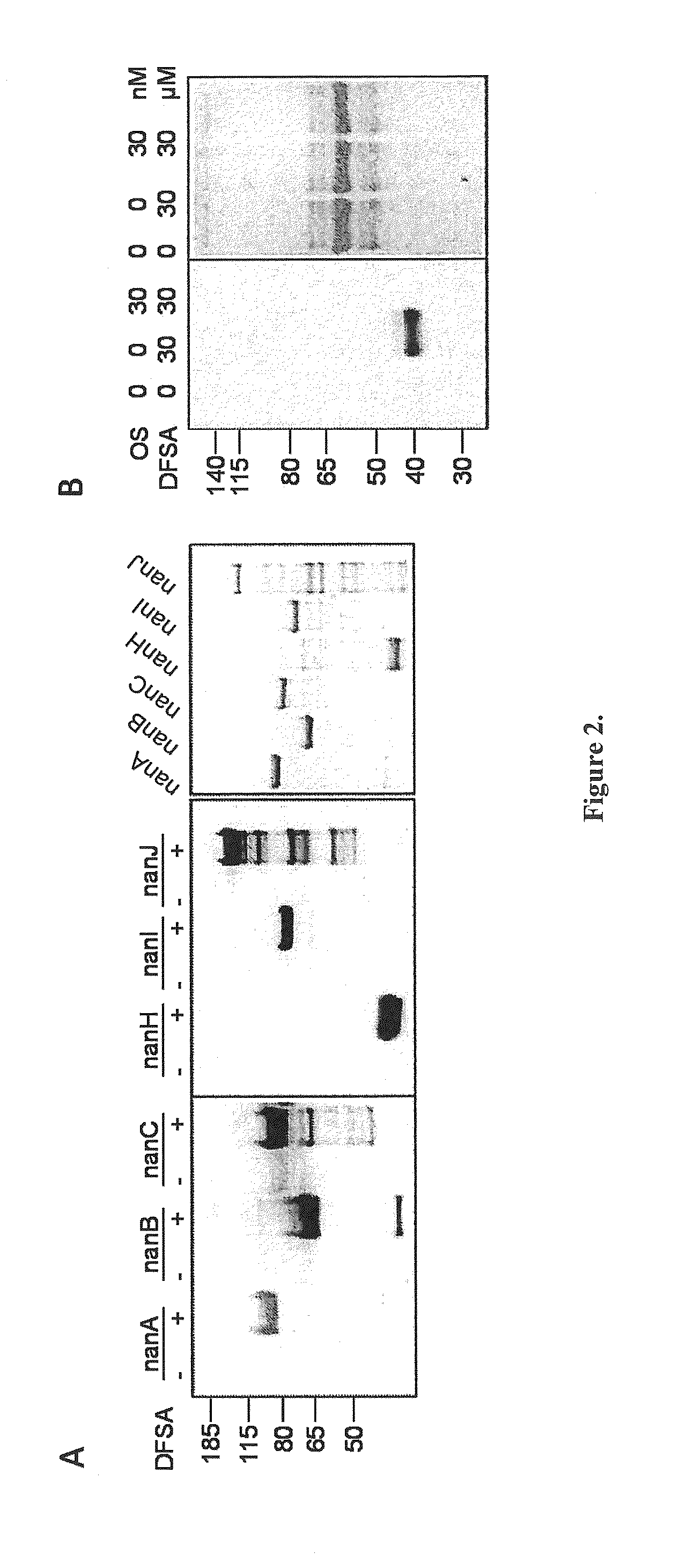Cell-permeable probes for identification and imaging of sialidases
a cell-permeable, sialidase technology, applied in the direction of instrumentation, esterified saccharide compounds, enzyme stabilisation, etc., can solve the problems of inability to apply probes to in situ labeling experiments, and often have non-specific labeling problems
- Summary
- Abstract
- Description
- Claims
- Application Information
AI Technical Summary
Benefits of technology
Problems solved by technology
Method used
Image
Examples
example 1
Methods and Materials
[0301]Unless otherwise noted, all compounds and reagents were purchased from Acros or Sigma-Aldrich. All chemicals were purchased as reagent grade and used without further purification. N-Acetylneuraminic acid aldolase was purchased from ToYoBo STC. Reactions were monitored with analytical thin-layer chromatography (TLC) in EM silica gel 60 F254 plates and visualized under UV (254 nm) and / or staining with acidic ceric ammonium molybdate or ninhydrin. Flash column chromatography was performed on silica gel 60 Geduran (35-75 μm, EM Science). 1H NMR spectra were recorded on a Bruker DRX-400 (400 MHz) spectrometer at 20° C. Chemical shifts were assigned according to the CHCl3 (6=7.24 ppm). 13C NMR spectra were obtained using Attached Proton Test (APT) on a Bruker DRX-400 (100 MHz) spectrometer and were reported using the signal of CDCl3 (6=77.0 ppm of central line) for calibration. Mass spectra were obtained by the analytical services of The Scripps Research Institu...
example 2
Methyl 5-(pent-4-ynamido)-2,4,7,8,9-penta-O-acetyl-3,5-dideoxy-3-fluoro-D-erythro-α-L-manno-non-2-ulopyranosonate (4)
[0302]A mixture of N-4-pentynoylmannosamine (460.0 mg, 1.78 mmol) (Z. Zhou and C. J. Fahrni, J. Am. Chem. Soc. 2004, 126, 8862.), 3-fluoropyruvic acid (as the sodium salt, 458.2 mg, 3.56 mmol), NaN3 (1%, 500 μL), and N-acetylneuraminic acid aldolase (200 U), in potassium phosphate buffer (pH 7.4, 0.05 mmol / L, 25.0 mL), was incubated at room temperature for 3 days. The mixture was concentrated. The residue was applied to a Dowex® column (1×2, 200 mesh), and eluted with water and formic acid (0.1-1.0 mol / L) sequentially. Fractions containing the desired product 2 were pooled, and concentrated under reduced pressure. The diastereomeric ratio (axial / equatorial=7:1) 2 was determined by NMR analyses.
[0303]To the crude product 2 were added MeOH (30 mL) and ion exchange resin Amberlite® IR 120-H (500 mg). The mixture was stirred at room temperature for 24 h, and filtered thro...
example 3
Methyl 5-(pent-4-vnamido)-4,7,8,9-tetra-O-acetyl-3,5-dideoxy-3-fluoro-D-erythro-α-L-manno-2-non-2-ulopyranosonate (5)
[0304]To a solution of compound 4 (165.0 mg, 0.28 mmol) in 10 mL of CH2Cl2 was added hydrazine acetate (116.0 mg, 1.26 mmol) in 2.0 mL of MeOH. The mixture was stirred at 0° C. for 8 h, and then concentrated under reduced pressure. The product 5 (110.0 mg, 72%) was obtained as an oil after silica gel column chromatography eluted with EtOAc / hexane (4:1). TLC (EtOAc / hexane=3:1) Rf=0.31. 1H-NMR (400 MHz, CDCl3+CD3OD) δ 5.46 (dd, J=2.4, 4.4 Hz, 1H), 5.39-5.26 (m, 2H), 4.97 (dd, J=2.4, 50 Hz, 1H), 4.76 (m, 1H), 4.46-4.34 (m, 2H), 4.20 (dd, J=7.4, 12.4 Hz, 1H), 3.85 (s, 3H), 2.54-2.40 (m, 2H), 2.36-2.30 (m, 2H), 2.17 (s, 3H), 2.11 (s, 3H), 2.09 (s, 3H), 2.07-2.05 (m, 4H). 13C-NMR (100 Hz, CDCl3+CD3OD) δ 173.7, 172.4, 171.9, 171.7, 171.6, 168.7, 95.5 (d, J=20.0 Hz), 88.5 (d, J=146.0 Hz), 83.5, 72.6, 71.2, 71.1, 71.0, 70.0, 69.3, 63.6, 53.4, 45.4, 36.1, 21.1 (2×), 21.0, 15.4....
PUM
| Property | Measurement | Unit |
|---|---|---|
| pH | aaaaa | aaaaa |
| pH | aaaaa | aaaaa |
| pH | aaaaa | aaaaa |
Abstract
Description
Claims
Application Information
 Login to View More
Login to View More - R&D
- Intellectual Property
- Life Sciences
- Materials
- Tech Scout
- Unparalleled Data Quality
- Higher Quality Content
- 60% Fewer Hallucinations
Browse by: Latest US Patents, China's latest patents, Technical Efficacy Thesaurus, Application Domain, Technology Topic, Popular Technical Reports.
© 2025 PatSnap. All rights reserved.Legal|Privacy policy|Modern Slavery Act Transparency Statement|Sitemap|About US| Contact US: help@patsnap.com



